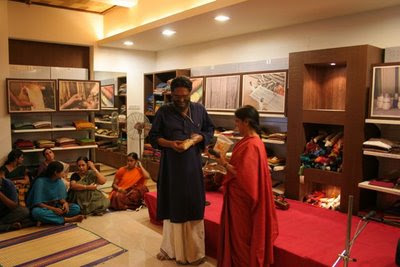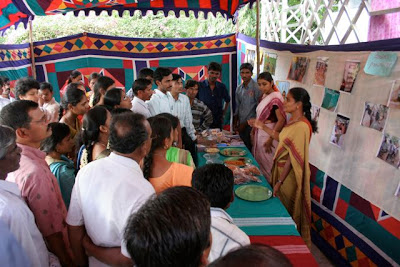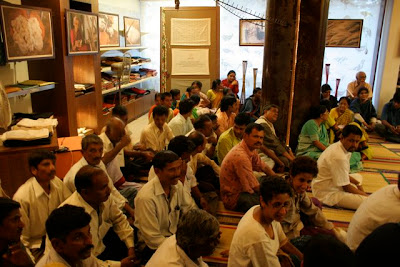Tuesday, January 27, 2009
Coming in February
I) 10th to 19th February
Traditional Kanjeevaram and Chettinad cotton and silk sarees of Tamil Nadu from Santanalakshmi pure silks and cottons, Bangalore.
1. Thalampoo pettu - Cotton body and silk border traditional sarees
2. Kasakasa kattam - Check cotton and silk cotton sarees
3. Priyangata - Check cotton sarees
4. Kandangi - Striped cotton sarees
5. Vyraoosi - Striped cotton sarees
Mango border, Kanjeevaram saree
Kanjeevaram saree
II) 13th February onwards
A new range of cotton handloom kurtis in different styles & cuts, weaves and block prints for the summer.
III) 21st February onwards
Shirts and kurtas for men for summer. Also introducing knee length kurtas in cotton handlooms
Dates: 21st February onwards
Monday, January 19, 2009
‘Chemical colours are carcinogenic’
| Workshop displays dyeing processes with eco-friendly colours |

Say it with eco-friendly hues: Children have a dekko at the dyeing process at a workshop on Saturday.
HYDERABAD: An elaborate and tedious procedure of cleaning, seasoning and colouring remains hidden behind the matt-finished handloom garments that are embellished in natural dyes. The whole process manifested itself before the eyes of those who attended the workshop organised by the Dastkar Andhra at their retail stores ‘Daram’ on Saturday.
The workshop displayed dyeing processes in natural as well as chemical colours that are eco-friendly.
“Chemical colours containing naphthol and sulphur are not good for health. Some are even carcinogenic. Reactive dyes, though chemical in content, are eco-friendly and do not cause any harm. They are widely preferred for exports as clothes dyed in harmful chemicals are not accepted abroad,” says Durga Lakshmi from Dastkar Andhra.
Dyeing in natural colours needs about ten to fifteen days as the process involves boiling the yarn to remove impurities, treating it with suitable tannin, and giving the alum treatment before the actual dyeing. The process differs slightly for the reactive colours as the yarn does not need the tannin treatment.
About seven eco-friendly colours and ten shades among them may be derived with various combinations of ratanjog, pomegranate peel, alizarin and indigo, said Ms. Durga Lakshmi.
The workshop with three phases of demonstration was attended by the students from various institutes of fashion technology and aficionados of handlooms and eco-friendly colours. Also part of the workshop was the demonstration of ‘kalamkari’ block printing with natural dyes.
Sunday, January 18, 2009
COLOURING COTTON SAFELY
In September last year, dāram conducted a day long workshop where dyers and block printers from across Andhra Pradesh demonstrated various techniques of dyeing yarn and printing hand woven cotton fabric using natural and safe dye materials.
Following is a short note we had prepared at that time on natural and safe dyeing:
NATURAL DYEING
Cotton yarn in natural dyes
Dyeing cotton yarn and fabric with natural materials like indigo, pomegranate, ratanjyot, katha, and areca, has been an age old practise across India and a vibrant palette has always existed. With the advent of chemical dyes, however, the technology of natural dyeing was badly affected and has been slowly disappearing.
One of Dastkar Andhra's key interventions over the last fifteen years has been to revitalise natural dyeing processes and to standardize a set of colours. Natural dyeing and the natural dyeing process has also received a new thrust with an increased focus on the environment and on being environment friendly.
The flow of colour from natural materials to cotton yarn is a fascinating process to watch. Our dyeing experts including Mohd. Saleem and Odelu will demonstrate the process.
REACTIVE DYEING
The invention of chemical dyes in Europe in the 1950s has taken the textile world by storm. The colours that we are familiar with come from these chemicals and the harm that some of them cause to the user and to the environment indirectly has been well documented. Reactive dyes are the closest to the natural dyes but they are yet to establish themselves in our domestic market. Reactive dyes are low ¨C impact synthetic dyes that are characterised by improved fixation rate, heavy metal free property, and good color fastness. Dastkar Andhra has initiated a process to move to reactive dyes recently and this is also linked to d¨¡ram's effort to spearhead the move towards more eco friendly dyes. Our event will include a demonstration of the reactive dyeing process.
HAND BLOCK PRINTING

Handblock printing, Machlipatnam
dāram is the only store in the country that promotes hand block printing on hand woven fabric. We have a range of garments with handloom fabric printed in the well known hand block printing centres of the country like Bagru and Kaladera (Rajasthan), Bhuj (Gujarat) and Machlipatnam (Andhra Pradesh).
Printing on powerloom / mill woven (mechanical looms) is the usual way that is followed by printers across the length of the country. We believe that linking hand weaving to hand block printing preserves the integrity of the process. It is an added advantage that the prints show up much better on hand woven fabric.
---
Also see
'Chemical colours are carcinogenic'
http://www.hindu.com/2008/09/08/stories/2008090860350400.htm
for a report in 'The Hindu' on the workshop
Monday, January 12, 2009
Weaving a success story
http://www.hindu.com/2009/01/12/stories/2009011251040200.htm
Eight youths from the weaver community, employed in odd jobs, find a viable vocation after training in weaving and dyeing

New skills: Youths from Kolluru village in Adilabad district attending a design workshop.
HYDERABAD: It was a skill that literally ran in their blood. But it was an opportunity that was missing for a good 20 years. For these eight rural youth from Kolluru village in Adilabad District, weaving might not have been a natural livelihood choice, but it surely paved a way out of their poverty.
For D. Bhaskar, A. Suresh, D. Damodar, D. Mahesh, D. Chandrashekar, D. Sampath. V. Nagesh and R. Srinivas, the wheel of fortune turned in their favour when they were identified by Dastkar Andhra (DA), a city-based NGO. Aged between 20 and 24, the eight hailing from the weaver community were living in abject poverty. Many had dropped out of school and had been employed in odd jobs.
MotivationTheir condition was brought to the notice of DA in 2006 when an older group of weavers in nearby Chennur informed them. A year’s training in weaving and dyeing, and the youth were all set to weave their own fortunes. “They were quick in grasping what was taught,” says V. Dharmender, in-charge, DA Production & Design, DA. Apart from appointing a master weaver to train them, DA also paid them a monthly stipend of Rs.1,000. “What motivated us to take up weaving was the fact that we didn’t have to work under anybody,” says D. Chandrasekhar.
Even after graduation, D. Sampath, a former teacher at a government school, finds weaving a sustainable livelihood optionHere to participate in a DA design workshop, they swear by their new found profession. Now named ‘Individual Weavers Co-operative Society’ as a group, they now earn anything between Rs. 6,000 to Rs. 9,000 individually per month.
“They are very confident now and have even paid back their bank loans,” says Ravinder of DA. He said they were identifying similar youngsters from backward regions of Andhra Pradesh. “As long as they are interested in learning weaving, DA is ready to assist them,” he says.”
----
Also see
http://www.dastkarandhra.org/
http://pankaj-atcrossroads.blogspot.com/2008/10/plight-of-indias-unskilled-weavers.htmlFriday, January 9, 2009
Monday, January 5, 2009
July 2008 - 1st anniversary celebrations of dāram
 bablu ganguly of the Timbaktu Collective launched timbaktu organic's organic foods in daram. timbaktu organic products are now available for the first time in Hyderabad
bablu ganguly of the Timbaktu Collective launched timbaktu organic's organic foods in daram. timbaktu organic products are now available for the first time in Hyderabad there was a cooking demonstration, followed by snacks made of millets and other products from timbaktu organic
there was a cooking demonstration, followed by snacks made of millets and other products from timbaktu organicSaturday, January 3, 2009
A short note on Dastkar Andhra
DASTKAR ANDHRA
Dastkar Andhra (DA) initiated its activities in 1989, as an off shoot of Dastkar Delhi. In 1996 DA was incorporated as a public charitable trust with the objectives of promoting artisan industries suited to ownership by the primary producers.
Dastkar Andhra's Objectives
- To establish viability of Handloom – as Livelihood, as Product and as Technology
- To work with weaver, weaver institution, market and state in achieving this
- Create a supportive policy process and environment
- To work with producer institutions that are equitable by design and in operation; strengthen institutions at the rural level, by making co-operatives more accountable to its members
- Impact the bargaining power of the weaver both in his immediate context (within co-op and other networks), with the market and the state
- Innovate on handloom market development and work on models for risk-taking and promotion
- Participate in industry growth by the training and dissemination routes, as well as the above
Facilitating participation and equity within and demonstrating the viability of the handloom industry are the long term aims of Dastkar Andhra. Its engagement with weaver communities is based on these principles, insisting on the need for transparency in transactions at all levels and control of different aspects of the production process by the producers themselves.
(dāram is an initiative of Dastkar Andhra (DA), the Dastkar Andhra Marketing Association (DAMA) and partner co-operatives, it is an effort to promote the handloom process and at the same time make good quality garments available to the customer at a reasonable price.)
















